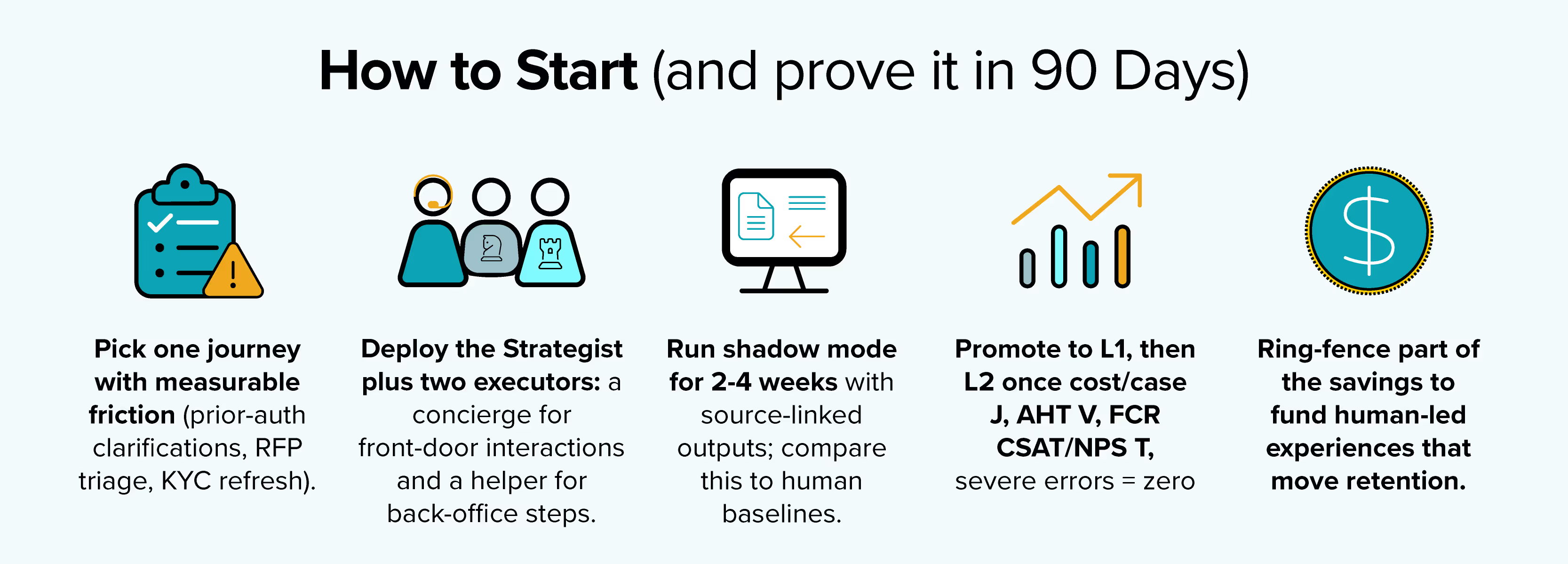The prevailing view of AI as a headcount reducer—especially in customer service—isn’t wrong, it’s just incomplete. In regulated sectors, cost reduction is mandatory and achievable. The strategic advantage comes from a Digital Strategist at every desk: a system that accelerates analysis, frames choices against policy and risk, and helps us decide cross-functionally where value is created or destroyed. Scaled across healthcare, insurance, and financial services, it compresses cost and grows the top line by uncovering patterns, opportunities, and bottlenecks no function can see on its own—without compromising oversight.
What a Digital Strategist is (and isn’t)
Not a chatbot, not a task bot. A Digital Strategist is an outcomes‑oriented system that sees across thousands of cases, recognizes patterns humans don’t have time to compute, and helps us decide which steps are worth doing, in what order, and for which customers. It is company‑bounded—limited to your products, policies, entitlements, and SLAs. It presents options with evidence, expresses uncertainty, and escalates when judgment belongs with a person. Around it, specialized agents—digital helpers, co‑workers, and concierges—execute the recommended steps under explicit guardrails.
Cost‑Out, Growth‑In: The Flywheel
AI should pay for itself fast. The pattern:
- Cost-Out (table stakes): Safely deflect and automate low-risk volume; shrink AHT and cost/case; keep severe errors ≈ zero via dialable autonomy (L0→L3).
KPIs: cost/case, AHT, FCR, severe-error rate, complaint ratio. - Insight-Up (top-line engine): Mine cross-case signals to improve conversion, retention, and portfolio mix; surface new product/pricing opportunities; recommend next best actions with evidence.
KPIs: conversion/attach, churn/retention, quote-to-bind (insurance), time-to-therapy & denial rate (healthcare), approval rate at constant risk (finserv). - Cross-Functional Shift (org unlock): Every important metric spans functions. The Strategist gives leaders a shared, evidence-linked view of journeys and trade-offs so they act across process/tech boundaries.
KPIs: end-to-end cycle time, handoff failure rate, rework, cross-team SLA hits, NPS/CSAT at lower cost. - Outcome: smaller, sharper human loops focused on decisions that move the P&L—no headcount padding implied.

Insurance: Lower handling cost, upgrade the book
- Cost-Out: Automate broker packet triage, appetite checks, and clarifications; reduce underwriter hours per case.
- Insight-Up: Score brokers by error/hit rate; highlight clauses affecting loss cost; shift quote-to-bind toward higher-margin segments.
- Cross-Functional: Distribution, underwriting, and claims act on one strategist view; portfolio mix improves without adding staff.
Healthcare: Reduce admin waste, improve adherence and time‑to‑therapy
- Cost-Out: Automate eligibility/benefits Q&A, documentation collection, and prior-auth pre-fills under PHI controls.
- Insight-Up: Spot denial patterns by facility/diagnosis; recommend interventions that cut avoidable utilization and shorten time-to-therapy.
- Cross-Functional: Payers/providers, care management, and benefits ops align on where to intervene; member retention and experience rise while costs fall.
Financial Services: Filter noise cheaply, focus on real risk and loyalty
- Cost-Out: Auto-resolve low-risk fraud/KYC alerts with evidence; bundle related signals to speed escalations; reduce handle time.
- Insight-Up: Learn counterparties/channels/time windows that need tighter controls; in servicing, drive retention with precise save/offers.
- Cross-Functional: Risk, ops, and CX operate from one evidence-linked plan; approval rates and satisfaction improve at constant or lower risk.
The Cross-Functional Unlock (why this wasn’t possible before)
Functions optimize locally; metrics like retention, loss ratio, and time-to-therapy are inherently cross-functional. The Strategist turns siloed transactions into a journey-level, evidence-linked model: what to do, why it matters, who should do it, and what it changes. That lets talented people spend more time designing cross-process moves (policy tweaks, product changes, channel shifts) instead of reconciling spreadsheets. The impact is structural: faster decisions, fewer handoffs, better outcomes.
Safety Is the Product in Regulated Markets
If it isn’t safe, it isn’t shippable. Four non‑negotiables:
- Bounded scope (sanctioned data/actions only).
- Dialable autonomy (L0→L3 gated by metrics and incidents).
- Auditability by default (immutable logs, per-decision rationale, data lineage, PII/PHI controls).
- Multi-objective evaluation (quality, cost, and risk—not speed alone).
How to Start (and prove it in 90 Days)

- Pick one journey with measurable friction (prior‑auth clarifications, RFP triage, KYC refresh).
- Deploy the Strategist plus two executors: a concierge for front‑door interactions and a helper for back‑office steps.
- Run shadow mode for 2–4 weeks with source‑linked outputs; compare this to human baselines.
- Promote to L1, then L2 once cost/case ↓, AHT ↓, FCR ↑, CSAT/NPS ↑, severe errors ≈ zero.
- Ring‑fence part of the savings to fund human‑led experiences that move retention.
Where Ushur Fits
At Ushur, this is the operating model: Digital Strategists that direct work, digital concierges and co-workers that execute within policy, and instrumentation that proves value and safety—continuously. Use AI to lower the cost to serve, raise organizational intelligence, and enable cross-functional execution. That’s how regulated enterprises deliver better experiences at lower cost—and why the advantage compounds.